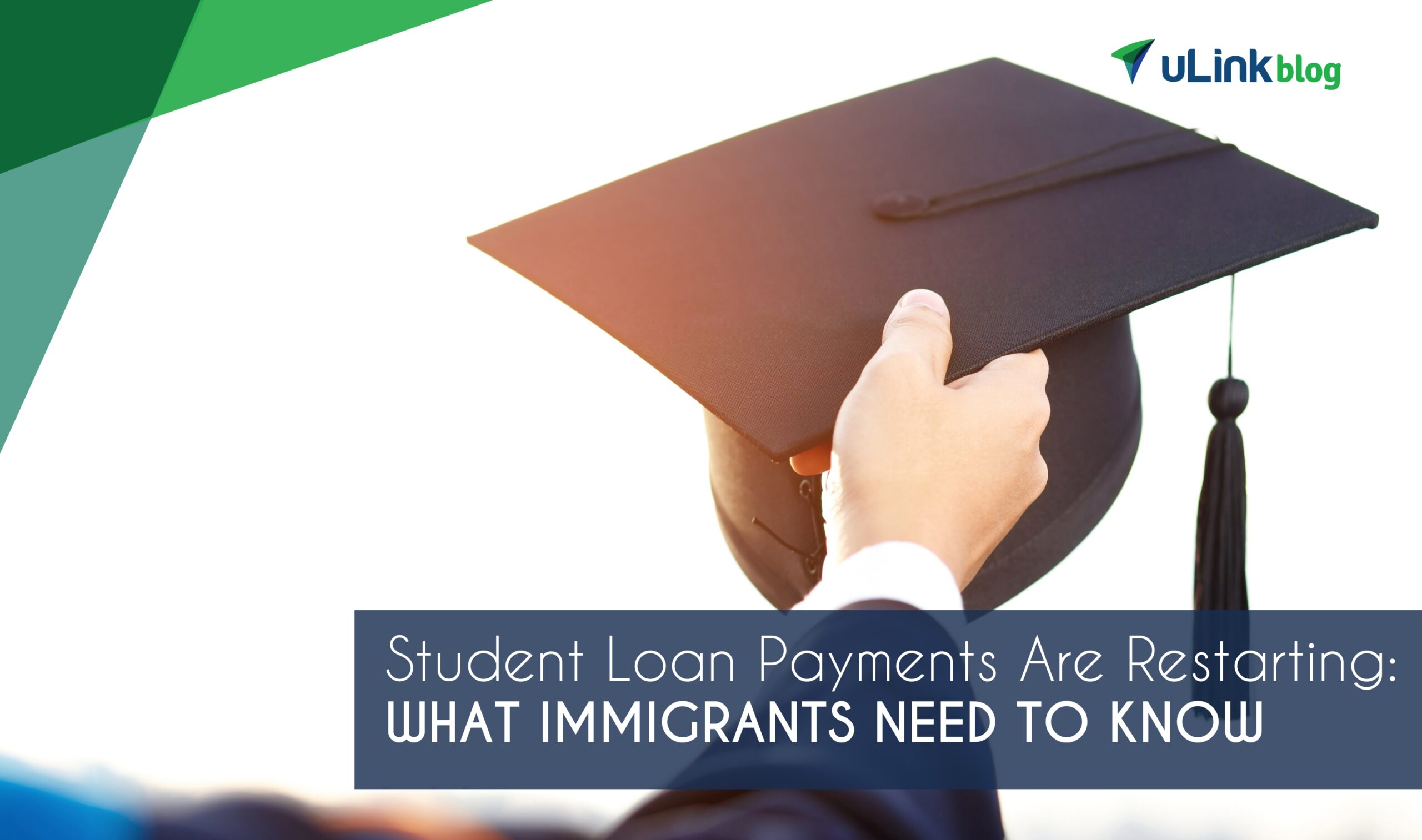
Student loan payments are back.
While millions of Americans hoped for loan forgiveness, the U.S. Supreme Court had other plans.
Now that the dust has settled, the facts are clear: starting October 2023, graduates are required to resume payments for the first time since March 2020.
Countless borrowers are understandably anxious about the restart of payments, especially in an economy marked by high inflation.
Given these uncertain times, it can seem impossible to make ends meet or know what the future holds—especially for immigrants adjusting to the complex U.S. financial system.
Today, we will provide much needed clarity so you can face the future with confidence.
In this article, we’ll take a deep dive into the state of student loans for immigrants and provide:
- A summary of how we got here since payments were paused in 2020.
- The details of the Supreme Court decision.
- The Biden Administration’s backup plan (and the “12-month on-ramp” for borrowers).
- The advantages of the latest income-driven repayment plan (IDR).
- The long-term consequences of non-payment and delinquency.
Before we dive in, make sure to review our student loan guide to understand what they entail.
Background: How We Got Here
The global pandemic affected practically every area of modern life.
Amid the emergency, the Trump administration paused student loan payments on March 13, 2020. They also set the interest rate to 0%, thereby preventing principal loan balances from incurring any additional growth.
Millions of Americans welcomed this decision, as they were burdened with over $1.6 trillion in total student loan debt.
Since the Biden administration took office in January 2021, the “administrative forbearance” has been extended an additional six times.
The Biden administration has also selectively canceled student loan debt for several million Americans.
In fact, over the last two-and-a-half years, it has approved $116 billion in loan cancellation for 3.4 million borrowers (many of whom are public service workers).
In addition to these advances, the Biden administration remained focused on providing a more comprehensive solution to loan forgiveness.
In August 2022, Biden officially unveiled his legislation for student loan forgiveness, which had been a prominent component of his presidential campaign.
His plan was clear: to forgive up to $10,000 in debt for borrowers earning less than $125,000 (and up to $20,000 in debt for borrowers who received Pell grants during college).
In total, the Biden administration sought to wipe out a whopping $400 billion in student debt.
Despite cross-party battles in congress, the Biden administration remained confident that the loan forgiveness legislation would pass.
However, as dissension escalated on Capitol Hill, the case (and the Biden administration) inspired a wave of litigation that eventually culminated before the U.S. Supreme Court.
The Supreme Court’s Decision (And Biden’s Response)
Legal cases often depend on judicial precedent.
In other words, U.S. courts and judges are bound by the doctrine of stare decisis, which means “to stand by things decided” in Latin.
Unfortunately, history proves hard to ignore, and the Biden administration’s loan forgiveness policy fell prey to precedent.
As it turns out, the proposed legislation was based on the HEROES Act, a little-known law enacted after the 9-11 terrorist attacks.
In short, the HEROES Act (i.e., Higher Education Relief Opportunities for Students) gave the Department of Education unilateral authority to alter legislation in times of national emergency.
While the HEROES Act seemed like a solid foundation for loan forgiveness, the Supreme Court swiftly shot it down.
Writing for 6-3 majority decision, Chief Justice Roberts said that the HEROES Act “does not allow the Secretary (of Education) to rewrite that statute to the extent of canceling $430 billion of student loan principal.”
Despite this defeat, President Biden remains committed to finding a solution.
As he told the press in June: “today’s decision has closed one path. Now we’re going to pursue another.” In fact, Biden said his administration would invoke a different law—the 1965 Higher Education Act—to lead a renewed attempt at achieving loan forgiveness.
While Biden’s backup plan is underway, it could take another six to nine months before it materializes.
What Immigrants Need to Know
Knowledge is power, and the three takeaways below will help position you for success as student loan payments start again.
1. Loan Accrual Restarted September 1
When does the student loan pause end? Let’s get the bad news out of the way early.
Emergency forbearance is over, and interest has already started accruing on federal student loans (as of September 1).
In other words, your principal balance is growing, which makes loan repayment all the more important.
2. Loan Repayments Resumed October 1
One more piece of bad news: loan repayments are starting up again October 1.
You’re not alone in this. In fact, over 45.3 million borrowers are getting ready to repay.
Here’s the good news: you’ll have access to some convenient student loan repayment plans where you could pay as little as $0 a month.
3. Biden’s “12-Month On-Ramp” Has Major Benefits
The Supreme Court rejection sent shivers down the spine of student loan borrowers.
The expectation of looming payments (and accruing interest) only made matters worse.
That’s why the Biden administration built a “12-month on-ramp” for borrowers, so the process of making payments could be easier than ever.
This on-ramp provides two amazing benefits: delinquency protection and revised income-driven student loan repayment plans.
For starters, the Biden Administration has ensured that any missed, late, or partial loan payments will not be reported to the credit bureaus (Experian, Equifax, and TransUnion).
While payments are still due (and interest continues to accrue), borrowers officially have reporting protection through September 30, 2024.
The Biden Administration has also overhauled income-driven student loan repayment plans with incredibly favorable terms.
In fact, the new Saving on a Valuable Education (SAVE) plan fully replaces the previous Revised Pay As You Earn (REPAYE).
Here’s the major difference: under the SAVE plan, many borrowers will only have to pay 5% of their monthly discretionary income—i.e., the money you have left over after paying for food, rent, transportation, taxes, and other essentials.
That’s why single borrowers earning $32,800 or less—or families of four earning $67,500 or less—might not have to pay anything on their loans.
More specifically, if you make roughly $15 an hour, your payments could be as low as $0.
Even if your income exceeds these limits, the Department of Education estimates you’ll still save over $1,000 a year under the new SAVE plan.
If you haven’t applied for the SAVE plan, Federal Student Aid can help guide you.
What’s Next
The Biden administration’s new debt relief program is coming.
Three rounds of public hearings will be underway on Zoom this fall (October 10-11, November 6-7, and December 11-12).
If you’re interested in joining these hearings (and asking questions to the committee), you’ll be able to do so. Stay tuned for more information.
In the meantime, try to make on-time payments whenever possible with the expectation that long-term loan forgiveness is coming.
The Financial Consequences of Non-Payment
“What’s the big deal? Why not just ignore the payments?”
These questions are both common and understandable.
Many Americans struggle to pay off credit card bills, let alone their student loan debt from a dusty old degree.
This problem long predates the pandemic.
In fact, according to Newsweek, nearly 60% of all borrowers had either stopped paying their loan bills or made $0 payments prior to 2020.
Today, 56% of borrowers claim they’ll have to choose between paying their student loan debt or covering their rent and groceries.
So, why not just ignore the payments altogether?
Here’s why: missed payments drive up penalties, fees, and interest. Even if you turn a blind eye to your student loan principal balance, the interest will grow every single day.
Over time, interest will accrue on interest and incur compound interest, which Albert Einstein famously deemed the eighth wonder of the world.
Beyond punitive interest, there are other dangerous consequences of avoiding your loan debt.
For example, if you let your loan payment go 90 days overdue, it’s officially considered “delinquent.” After the grace period ends on September 30, 2024, all delinquent bills will be reported to the credit bureaus.
Before long, your credit score will take a hit and reduce your access to financial tools like personal loans, mortgages, and credit cards.
Worse yet, if you default on federal student loans, the government could garnish your wages,
seize your tax refund, and if you’re over age 62, tap into your hard-earned Social Security benefits.
Note that, in most cases, a student loan is in default after 270 consecutive days without payment.
What about declaring bankruptcy?
In the vast majority of cases, federal student loans cannot be discharged in bankruptcy (according to 2005 legislation).
Ignoring your student loan debt is a perilous decision that could wreck your financial health for decades on end.
That’s why the updated income-driven student loan repayment plans are so powerful. While they will demand a portion of your monthly earnings, the SAVE plan can dramatically reduce your overall burden, so you can live with confidence.
A Brighter Tomorrow
Unfortunately, debt is a part of life in the US.
The average American holds a debt balance of over $101,000, while 43.5 million people in the US have over $1.7 trillion in student loans.
You’re not alone in the fight.
While the first few months of loan repayments may be challenging, know that each payment is getting you closer to financial freedom.
Plus, as you make payments, don’t forget that the Department of Education is hard at work on developing a new student loan forgiveness proposal.
In the meantime, income-driven student loan repayment plans can help reduce your monthly debt burden.
At uLink, we truly admire your tenacity.
While you build your life in America (and pay down student loans), we recognize that you’re also working diligently to care for your loved ones overseas.
That’s why we’re dedicated to helping you send more money home than ever before.
With great exchange rates and fees as low as $0, you can support your family in a fast and affordable way.
Miles from home—just moments away with uLink.









